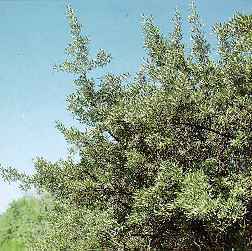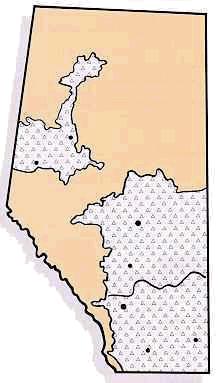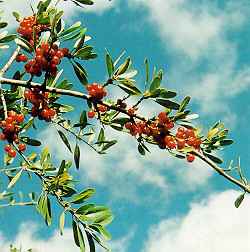| | Plant characteristics | Nitrogen fixing | Site Preference | Hardiness | Uses | Problems | Pruning
.

Scientific Name: Shepherdia argentea (Pursh) Nutt.
Plant Characteristics
Native to North America, this shrub grows on the prairies from Manitoba to Saskatchewan. Commonly found around sloughs, in coulees, and on light soils on the prairies.
Silver buffaloberry is a large, thorny shrub or small tree with multi branches. It reaches a height from 2 to 4 m (6 to 12 ft) with a spread of up to 3.5 m (11 ft). It is an erect shrub with an open structure, suckers freely and forms a dense irregular hedge. This is a slow growing shrub, that can live 25+ years. It can grow from 10 to 30 cm (9 to 12 in.) a year.
Leaves - Leaves are simple and opposite, small, 5 mm to 2.5 cm (0.25 to 1 in.) long and silvery in colour, edge smooth, elliptic in shape. The leaves and branches have a dense silvery scale when young.
Flowers - Dioecious, yellow flowers are inconspicuous and small brownish clusters at nodes formed in the preceeding season. Flowers are 5 mm (0.25 in.) and bloom in spring.
Fruit - Reddish orange, 3 to 5 mm (to 0.25 in.) in diameter, develop late in August to September. Fruit is very sour, but a hard frost improves taste, very good for jams and jelly.
Bark - Grey and smooth when young, dark and rough when old.
Nitrogen Fixing
Silver buffaloberry has some capacity for nitrogen fixing.
Site Preference
It is commonly found around sloughs, in coulees, and on light soils. It is largely confined to medium textured soil. Although it prefers moist, well drained sites, it will tolerate some spring flooding.
Silver buffaloberry is very drought resistant.
It does best in full sun, and will not tolerate shade. It is good for nutrient-poor soils.
Hardiness
Extremely winter hardy.
.


Uses
Accent planting, food for wildlife, reclamation. Can be used in the outside row of farmstead shelterbelts, but also in field and roadside belts. The limited height and open structure of this shrub make it of limited use as an effective wind barrier. The fruit is readily eaten by birds. The colour of the foliage gives the value as an ornamental. Fruit will only form if a number of plants are planted together so that male and female plants are present. The shrub is utilized by wildlife for cover and food. The recommended planting distance in a single row is 1 to 1.5 m (3 to 4.5 ft) apart.
Problems
Irregular growth habit may be considered undesirable. Suckering can be controlled by cultivation.
Pruning
As required to maintain shape and size. Old, crossing, dead, diseased or weak stems should be removed. Caution thorns.

Shelterbelts Varieties for Alberta provides information on a number of other trees and shrubs than may be suitable for shelterbelts.
Visit our website directory for the Reforestation Woodlot Listings. |
|